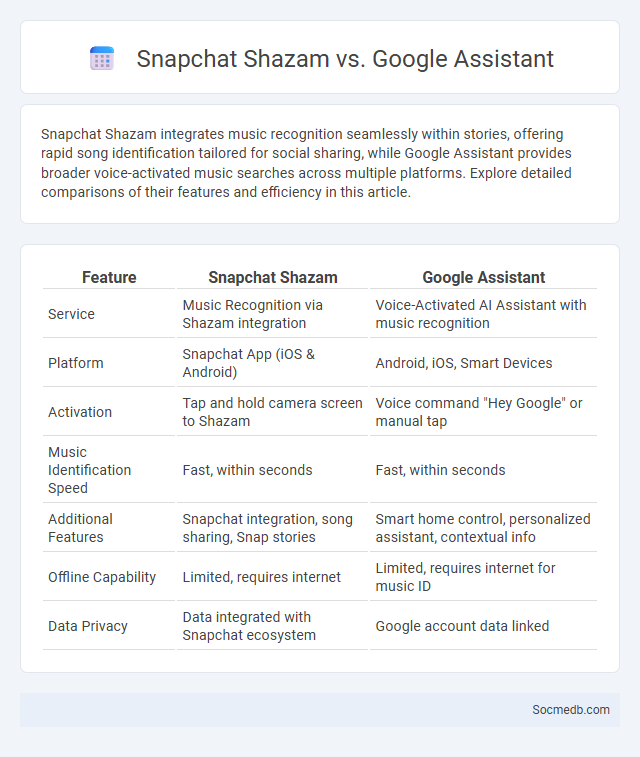
Photo illustration: Snapchat Shazam vs Google Assistant
Snapchat Shazam integrates music recognition seamlessly within stories, offering rapid song identification tailored for social sharing, while Google Assistant provides broader voice-activated music searches across multiple platforms. Explore detailed comparisons of their features and efficiency in this article.
Table of Comparison
| Feature | Snapchat Shazam | Google Assistant |
|---|---|---|
| Service | Music Recognition via Shazam integration | Voice-Activated AI Assistant with music recognition |
| Platform | Snapchat App (iOS & Android) | Android, iOS, Smart Devices |
| Activation | Tap and hold camera screen to Shazam | Voice command "Hey Google" or manual tap |
| Music Identification Speed | Fast, within seconds | Fast, within seconds |
| Additional Features | Snapchat integration, song sharing, Snap stories | Smart home control, personalized assistant, contextual info |
| Offline Capability | Limited, requires internet | Limited, requires internet for music ID |
| Data Privacy | Data integrated with Snapchat ecosystem | Google account data linked |
Introduction to Music Recognition Apps
Music recognition apps utilize advanced audio fingerprinting technology to identify songs from short sound clips with high accuracy. These apps analyze unique patterns in melody, rhythm, and lyrics by comparing them against extensive music databases in real-time. Popular platforms like Shazam and SoundHound provide seamless integration with streaming services, enabling users to discover new music instantly.
Overview of Snapchat Shazam Integration
Snapchat Shazam integration allows users to instantly identify songs playing around them by simply pressing the Shazam button within the Snapchat app. This feature enhances your social media experience by seamlessly combining music discovery and sharing through Snapchat's interactive platform. By leveraging Shazam's robust music recognition technology, Snapchat offers real-time song identification that users can share directly in their snaps and stories.
Features of Google Assistant’s Song Recognition
Google Assistant's Song Recognition feature accurately identifies music playing nearby by analyzing audio patterns in real time, leveraging machine learning algorithms. It supports seamless integration with social media platforms, allowing users to share recognized songs instantly through messaging apps and social networks. The feature also provides detailed song information, including artist, album, and lyrics, enhancing user engagement and music discovery across social channels.
Standalone Shazam App Capabilities
The Standalone Shazam app offers powerful social media integration by enabling You to instantly identify songs and share your discoveries across platforms like Instagram, Facebook, and Twitter. Its advanced audio recognition technology quickly detects music playing nearby, providing detailed artist information, lyrics, and music videos to enhance your social media content. This seamless sharing capability drives greater engagement and helps You connect with a community of music enthusiasts worldwide.
User Experience Comparison
Social media platforms vary significantly in User Experience, with factors such as interface design, content personalization, and interaction speed shaping how users engage. Your satisfaction often depends on seamless navigation, algorithm accuracy in content delivery, and responsiveness to user feedback, which differ across platforms like Instagram, Twitter, and TikTok. Evaluating these elements helps you choose a social network that maximizes engagement and enjoyment.
Speed and Accuracy of Music Detection
Music detection on social media platforms leverages advanced algorithms and AI to deliver rapid and precise identification of songs within seconds. This technology ensures Your content is accurately tagged with correct artist and track information, enhancing user engagement and content discoverability. Real-time speed combined with high accuracy minimizes errors, providing a seamless experience for music lovers and creators alike.
Privacy and Data Handling
Social media platforms collect vast amounts of personal data, making privacy protection and secure data handling crucial for safeguarding your information. Implementing strong encryption and transparent data policies helps prevent unauthorized access and misuse of sensitive user data. Being aware of privacy settings allows you to control what information is shared and enhances your overall online security.
Integration with Other Apps and Services
Seamless integration with other apps and services enhances your social media experience by enabling effortless content sharing and cross-platform connectivity. APIs and third-party tools allow synchronization of calendars, messaging apps, and cloud storage, streamlining workflows and boosting productivity. Leveraging these integrations can help you optimize engagement and maintain consistency across all digital channels.
Unique Pros and Cons of Each Option
Facebook excels in community building and detailed targeting for advertisers but faces criticism for privacy concerns and algorithmic bias. Instagram offers strong visual engagement and influencer marketing opportunities, yet struggles with mental health impact and content moderation challenges. Twitter provides real-time news updates and open discourse but deals with issues of misinformation, harassment, and limited content depth.
Conclusion: Choosing the Best Music Recognition Tool
Selecting the best music recognition tool depends on accuracy, speed, and compatibility with your social media platforms. Your ideal choice should provide seamless integration, real-time identification, and support for a wide range of music databases to enhance your content's engagement. Prioritize tools with positive user reviews and consistent updates to ensure reliable performance in your social media activities.
 socmedb.com
socmedb.com